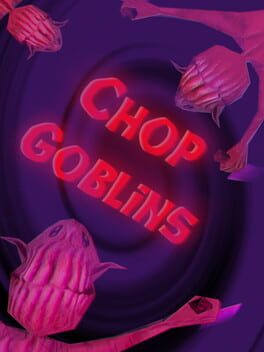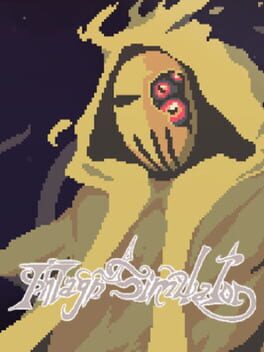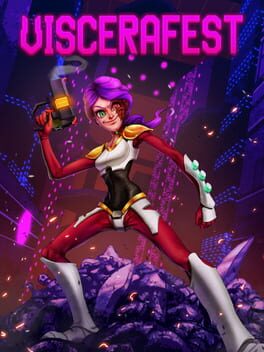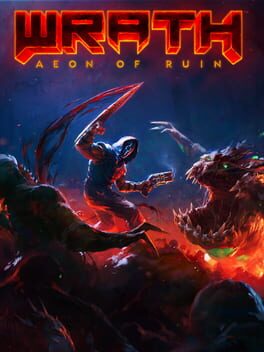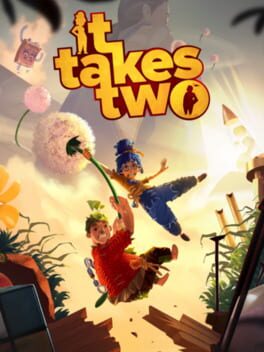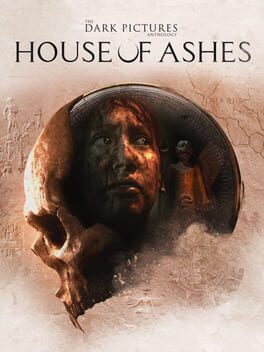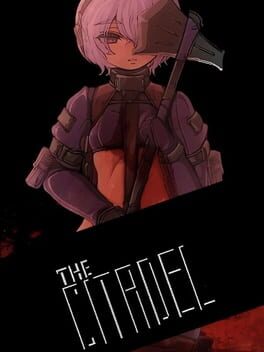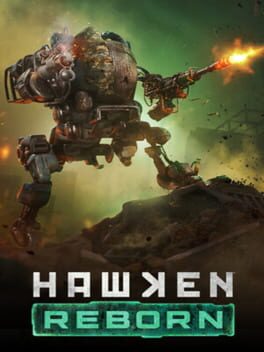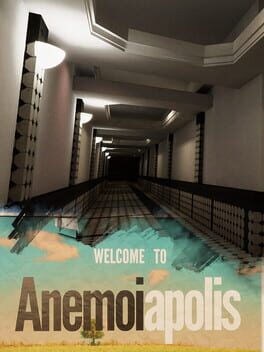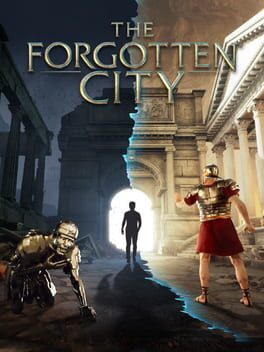AuTomaton
2022
Chop Goblins is small and simple, and hides its craftsmanship under that layer of simplicity and simpleness. Most elements of the game are there just enough to create unique and thoughtful gameplay experiences. Despite such a small weapon and enemy palette, each level tells its own story with its own gameplay and environment elements. Those tiny environment elements really do a lot of heavy lifting with making each level feel like a special experience.
It also genuinely surprised me how well balanced around weapon affordances the harder gamemodes were. Playing Goblin Mode with the original weapon progression versus playing it with secrets/Once Again Mode weapons is a totally different experience. The game you play between those two modes is so different it almost feels like two different gamemodes packaged into one game setting, with the actual dividing logic being the player's own prior knowledge or game choices.
It also genuinely surprised me how well balanced around weapon affordances the harder gamemodes were. Playing Goblin Mode with the original weapon progression versus playing it with secrets/Once Again Mode weapons is a totally different experience. The game you play between those two modes is so different it almost feels like two different gamemodes packaged into one game setting, with the actual dividing logic being the player's own prior knowledge or game choices.
2023
2022
2021
Difficulty is the interesting artistic decision in Viscerafest. Viscerafest wants to be played in a very specific way, or you will not progress. Now, if you play on lower difficulties, you'll probably figure out what that way is eventually, but Viscerafest relies heavily on genre literacy in making sure the player can play. That is to say, the tutorial is entirely insufficient and Viscerafest just expects you to know better. Normally I personally would see that as a negative, but the game's repeated and very clear communication that it is hard makes me second guess myself. Is expecting players to be good from the get-go a valid artistic choice? Would Viscerafest be worse if it didn't? I really don't know. Maybe when the game is out of Early Access I'll be able to tell.
Oh, and the rest of the game is fine. It's just not as interesting of a discussion point as the difficulty/tutorial/genre knowledge thing.
Oh, and the rest of the game is fine. It's just not as interesting of a discussion point as the difficulty/tutorial/genre knowledge thing.
2019
WRATH might still be in Early Access, but there's a lot to say about its excellent art, its daring rationing of saves, and it's deceivingly poor level and enemy design.
I say deceivingly poor because the guns, levels, and enemies feel so good -at first- that you might not notice on higher difficulties. Enemies are visually interesting and ferocious. Levels are lovingly detailed, daunting, and intricately brought to live. The weapons are unique, clear to use, and generous with their screen time (you'll be using all of them often). As far as first impressions go, Wrath does well.
However, the actual play of these levels starts to fall off pretty quickly. Levels a huge and detailed and feature many interesting nooks and crannies, but are surprisingly linear. There are swooping, looping, serpentine paths through most levels, and the game will make you traverse them in their entirety. There are many sections where the player will travel a great distance, fight hordes of monsters, and spend many resources to ultimately move only a few feet forward. The player's progression speed relative to how much danger they have to go through is very slow.
Despite having quite a few lovingly rendered and presented enemies, Wrath relies on only a small handful, and how these enemies get used is surprisingly boring. Wanna jumpscare players? Heretics. Wanna force high-risk close-range situations? Heretics. Wanna snipe the player from far away? Heretics. In combination with poor enemy pathing logic and an over-reliance on enemy groups (Heretics and Stricken usually appear in groups of 3-5 and 1-3, respectively, despite their large threat and resource cost), it feels like 20%-25% of enemies in Wrath simply wait by a corner for the player to walk through before mauling them. Enemies are well suited to their level locations for killing the player, but not necessarily for a fun and interesting game experience.
Both of these problems are compounded heavily by the game's limited save system. I respect the absolutely gigantic balls needed to publish such a system, and I think Wrath's Soul Tethers are one of the better executions of limited saves. Giving the player so much control over their ability to save allow players to choose what fights, what checkpoints, and what landmarks matter to them. And Soul Tethers aren't really that rare either, so it rarely feels like it's impossible to save.
The issue with Soul Tethers (other than the standard accessibility issues of not being able to exit the game when needed) is that it amplifies play-session length. The large, meandering levels fade into grueling slogs when the player feels that they're not allowed to stop. Soul Tethers can only be regained by making more progress, so a player's only way out of having to play is to continue playing. Players don't make slow, footdragging progress to objectives, players make slow, footdragging progress to getting to move on with their day. Players don't get ambushed to death and lose progress, they get ambushed to death and lose all the work they didn't even want to do in the first place to leave. Soul Tethers exaggerate Wrath's main issues because they add extreme risk and stakes to every single fight the player engages in.
I will say that the levels are absoultely beautiful. I haven't seen boomshoot crunch combined will genuine level detail in such a unique and complete way before. If anything, Wrath's gigantic and inspiring levels make play feel like a genuine adventure. The colossal challenge presented to you feels daunting to face, but not insurmountable.
Given that Wrath's issues are deeply built into its already huge (and I'd assume complex) levels and core mechanics, I doubt the issues I have with it will improve by the time this game is out of Early Access. But, Early Access is Early Access, so time may tell a different story. I guess we'll see.
I say deceivingly poor because the guns, levels, and enemies feel so good -at first- that you might not notice on higher difficulties. Enemies are visually interesting and ferocious. Levels are lovingly detailed, daunting, and intricately brought to live. The weapons are unique, clear to use, and generous with their screen time (you'll be using all of them often). As far as first impressions go, Wrath does well.
However, the actual play of these levels starts to fall off pretty quickly. Levels a huge and detailed and feature many interesting nooks and crannies, but are surprisingly linear. There are swooping, looping, serpentine paths through most levels, and the game will make you traverse them in their entirety. There are many sections where the player will travel a great distance, fight hordes of monsters, and spend many resources to ultimately move only a few feet forward. The player's progression speed relative to how much danger they have to go through is very slow.
Despite having quite a few lovingly rendered and presented enemies, Wrath relies on only a small handful, and how these enemies get used is surprisingly boring. Wanna jumpscare players? Heretics. Wanna force high-risk close-range situations? Heretics. Wanna snipe the player from far away? Heretics. In combination with poor enemy pathing logic and an over-reliance on enemy groups (Heretics and Stricken usually appear in groups of 3-5 and 1-3, respectively, despite their large threat and resource cost), it feels like 20%-25% of enemies in Wrath simply wait by a corner for the player to walk through before mauling them. Enemies are well suited to their level locations for killing the player, but not necessarily for a fun and interesting game experience.
Both of these problems are compounded heavily by the game's limited save system. I respect the absolutely gigantic balls needed to publish such a system, and I think Wrath's Soul Tethers are one of the better executions of limited saves. Giving the player so much control over their ability to save allow players to choose what fights, what checkpoints, and what landmarks matter to them. And Soul Tethers aren't really that rare either, so it rarely feels like it's impossible to save.
The issue with Soul Tethers (other than the standard accessibility issues of not being able to exit the game when needed) is that it amplifies play-session length. The large, meandering levels fade into grueling slogs when the player feels that they're not allowed to stop. Soul Tethers can only be regained by making more progress, so a player's only way out of having to play is to continue playing. Players don't make slow, footdragging progress to objectives, players make slow, footdragging progress to getting to move on with their day. Players don't get ambushed to death and lose progress, they get ambushed to death and lose all the work they didn't even want to do in the first place to leave. Soul Tethers exaggerate Wrath's main issues because they add extreme risk and stakes to every single fight the player engages in.
I will say that the levels are absoultely beautiful. I haven't seen boomshoot crunch combined will genuine level detail in such a unique and complete way before. If anything, Wrath's gigantic and inspiring levels make play feel like a genuine adventure. The colossal challenge presented to you feels daunting to face, but not insurmountable.
Given that Wrath's issues are deeply built into its already huge (and I'd assume complex) levels and core mechanics, I doubt the issues I have with it will improve by the time this game is out of Early Access. But, Early Access is Early Access, so time may tell a different story. I guess we'll see.
2021
2021
Forgive Me Father has too much going on. The player is given to many abilities, weapons, and skills, and very few other them synergize well enough to be made into an entire arsenal or strong enough on their own to be the center of play. That being said, Forgive Me Father is still enjoyable to play. The unique artstyle is executed well, and the game has enough of its own special moments to support its fiction. Would benefit from being cut down in size, I think.
House of Ashes (and presumably the entire Dark Pictures Anthology, I haven't played the rest) makes the intelligent decision of using its framing devices to enhance the feeling that House of Ashes is an interactive movie, and not really a game. That movie has some awkward cuts, but as long as you're okay with letting the film take you along for the ride, you'll enjoy yourself regardless.
2022
Deadlink is generally alright in every meaningful metric. The only weak spot is that the game is afraid to make the player powerful. The game's difficulty doesn't come from rooms or enemies or hazards requiring high levels of execution to beat. Deadlink just keeps you on training wheels more or less the entire run (assuming you aren't lucky to roll a bunch of synergizing implants, but that's not a skill issue).
I'll come back around when Deadlink is out of early access, it could really use the time.
I'll come back around when Deadlink is out of early access, it could really use the time.
2020
The Citadel's gunplay is okay, in that the weapons shoot and do damage and that's fun, but there are a lot of tacked on mechanics that don't fit with each other. Lean-aiming, low player health, and very particular timing and penalties around reloading indicate that The Citadel is played slow and tactically. Open levels, high move speeds, and roof-to-roof mobile combat suggest running and gunning. These mechanics don't support each other, and they don't overlap enough to warrant a "pick how you play" approach to the game. I found myself leaning into tactical play simply because such a play style has more mechanical punishments to juggle.
The Citadel's environment and prop art is acceptably bland; not good but with enough consistency to still create a readable artistic picture. The sound design doesn't do as well The music does fit the game, sometimes, but the remaining audio elements lack a purpose other than to check the box of being there, with one exception:
The Citadel's got a lot of moe murder, and it's unnervingly brutal. At first I thought that was the point: the painful, dissonant anguish of a world in such inhuman/posthuman peril. But the player is so empowered in their brutality that I feel like I'm supposed to enjoy it? It's very creepy, and not in an enjoyable way.
The Citadel's environment and prop art is acceptably bland; not good but with enough consistency to still create a readable artistic picture. The sound design doesn't do as well The music does fit the game, sometimes, but the remaining audio elements lack a purpose other than to check the box of being there, with one exception:
The Citadel's got a lot of moe murder, and it's unnervingly brutal. At first I thought that was the point: the painful, dissonant anguish of a world in such inhuman/posthuman peril. But the player is so empowered in their brutality that I feel like I'm supposed to enjoy it? It's very creepy, and not in an enjoyable way.
2023
Has a lot of usability, performance, and concept issues. And I don't know why a singleplayer game has cloud syncs and microtransactions. I'd rather just pay for it? And it's not beating the AI art allegations for the cutscenes. Buyer beware.
Game's not great, but it's also in early access and hasn't even been available for a day. I'm gonna check back in a year before actually reviewing this game, as Hawken Reborn on release really isn't ready enough to be critiqued.
Game's not great, but it's also in early access and hasn't even been available for a day. I'm gonna check back in a year before actually reviewing this game, as Hawken Reborn on release really isn't ready enough to be critiqued.
2023
DREDGE is a lovely little scavenger hunt of oceanic horror, capitalistic overeagerness, and a cynical viewing of the alien realm of the sea. The game doubles down hard on the sea-monsters-and-Lovecraft angle of fishing mythology, and it's mosty enjoyable and unnerving while the mystery holds up. Eventually DREDGE does lift the curtain for the sake of its story, which spoils a little bit of the fun, but not so much to make the ending of the game dissatisfying.
The environments in DREDGE are put together that to encourage players to take risks with their vessels while still feeling sufficiently hostile and aggressive. The game is very formulaic in how its exploration is laid out (One quest, trinket, rare fish, cultists, slab, etc) which makes progression a routine towards the end. DREDGE has trouble keeping its experience together as it ends because of this. The first 1 or 2 islands will feel like unknown, mysterious, even alien places, while those following will feel more like a pretty checklist that follows the gameplay path of the last 2 or 3 areas.
The environments in DREDGE are put together that to encourage players to take risks with their vessels while still feeling sufficiently hostile and aggressive. The game is very formulaic in how its exploration is laid out (One quest, trinket, rare fish, cultists, slab, etc) which makes progression a routine towards the end. DREDGE has trouble keeping its experience together as it ends because of this. The first 1 or 2 islands will feel like unknown, mysterious, even alien places, while those following will feel more like a pretty checklist that follows the gameplay path of the last 2 or 3 areas.
2023
It Comes in Waves is nothing special mechanically, but you're not here for the looting or shooting. You're here for the journey. You're here for the desert planet. You're here for the moments of quiet desperation.
Instead of telling you who you are, your character is a mirror for sparse characters to react to. Through those reactions you get placed into a headspace that doesn't necessarily tell you to feel regret, but that still presses that social force down on your head.
Fighting others is fairly simply and easy, but its the change in the thought process of why you fight is what is special. First you move to self-defense maybe to pre-emptive self-defense maybe to weight each digital life's water with the opportunity cost of spending the water it'll take to chase them down.
It Comes in Waves is able to place you into the world and give you the tools and affordances needed not only to help you feel like you belong to the world, but to also begin to build out how you feel about each sparse interaction and feature and meaning of the endless wash of sand.
It's also quite pretty.
Instead of telling you who you are, your character is a mirror for sparse characters to react to. Through those reactions you get placed into a headspace that doesn't necessarily tell you to feel regret, but that still presses that social force down on your head.
Fighting others is fairly simply and easy, but its the change in the thought process of why you fight is what is special. First you move to self-defense maybe to pre-emptive self-defense maybe to weight each digital life's water with the opportunity cost of spending the water it'll take to chase them down.
It Comes in Waves is able to place you into the world and give you the tools and affordances needed not only to help you feel like you belong to the world, but to also begin to build out how you feel about each sparse interaction and feature and meaning of the endless wash of sand.
It's also quite pretty.
The idea of Anemoiapolis, the eternally expanding beige-carpet nightmare of 80s hotels, is a good one, and the game executes a decent rendition of what such an environment would look like in an explorable 3D space. However, the game misses just about every other mark it aims for. It is too open, too empty, and too insistent on how the player is supposed to feel about the space. Anemoiapolis leaves behind an experience that less than engaging, let alone scary.
There is no meaningful tension build or sense of unease in Anemoiapolis. This isn't really a problem itself, but this lack of tension clashes with character dialogue that suggests an unease and desperation that just isn't there. The emotions engendered by the environment aren't allowed to speak for themselves.
The areas of Anemoipolis are not emotionally interesting either. The best are confusing and unnerving investigations of intentionally difficult spaces, and the rest are just carpet mazes. The game needs to fall about on Backrooms-tier paranormal nonsense to get a genuine rise out of players, which is another strike in the "won't let the environment speak for itself" book.
Anemoiapolis is also really slow to navigate, due to how big the environment is and how slow the player moves. Seeing how Anemoiapolis is an empty set of rooms with little to look at or interact with, walking around gets really boring really fast.
There is no meaningful tension build or sense of unease in Anemoiapolis. This isn't really a problem itself, but this lack of tension clashes with character dialogue that suggests an unease and desperation that just isn't there. The emotions engendered by the environment aren't allowed to speak for themselves.
The areas of Anemoipolis are not emotionally interesting either. The best are confusing and unnerving investigations of intentionally difficult spaces, and the rest are just carpet mazes. The game needs to fall about on Backrooms-tier paranormal nonsense to get a genuine rise out of players, which is another strike in the "won't let the environment speak for itself" book.
Anemoiapolis is also really slow to navigate, due to how big the environment is and how slow the player moves. Seeing how Anemoiapolis is an empty set of rooms with little to look at or interact with, walking around gets really boring really fast.
2021
